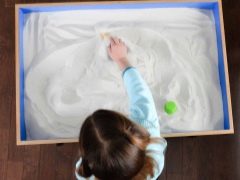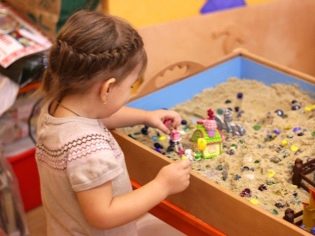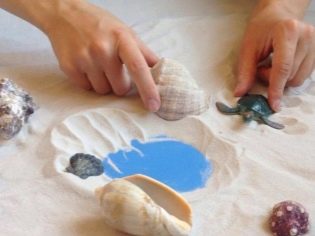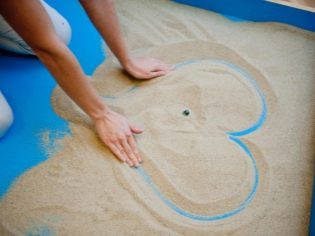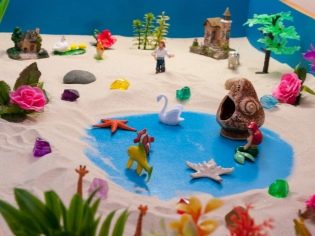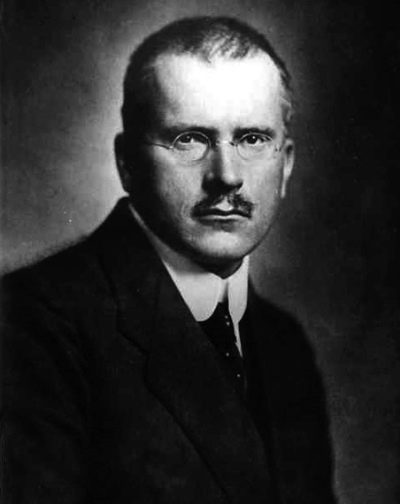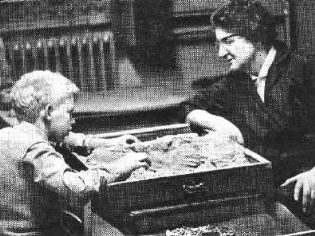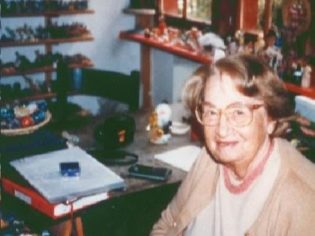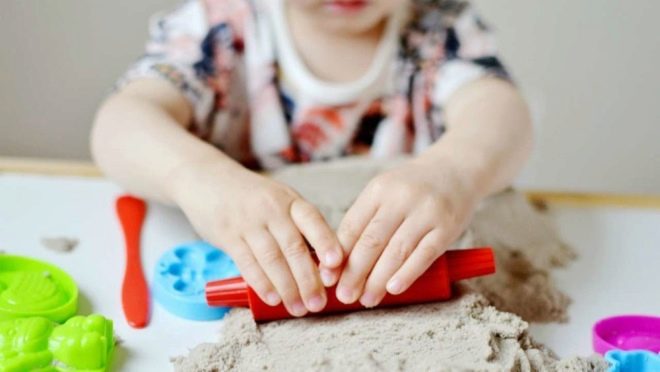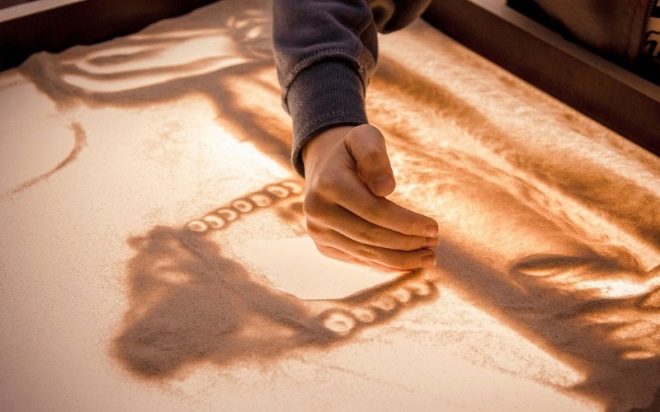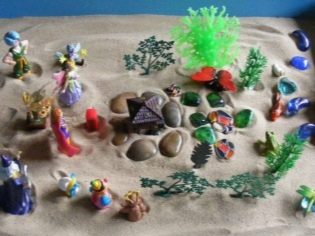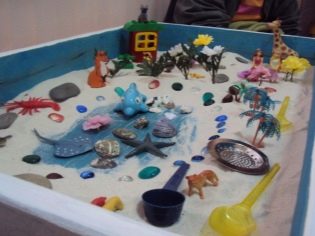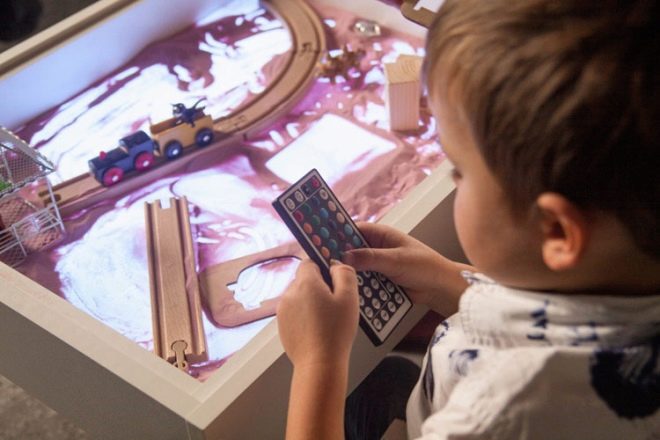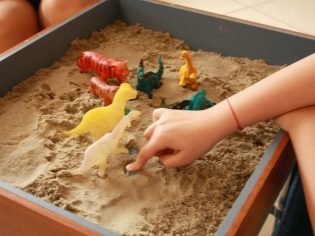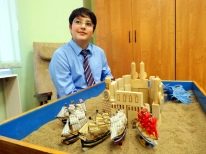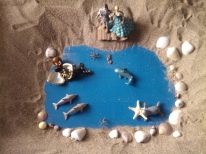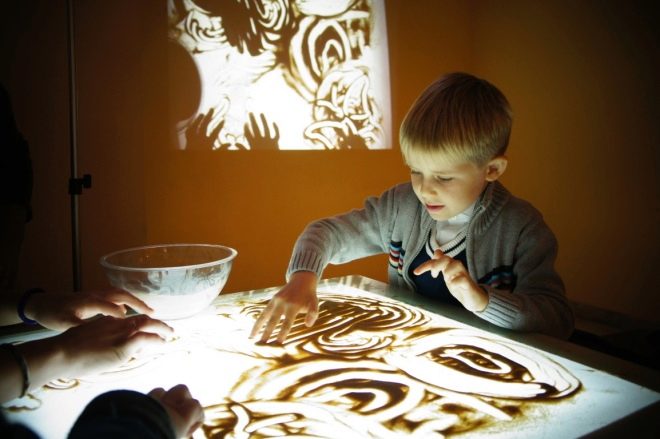What is sand therapy and how does it help children?
Many parents have heard about the amazing results that sand therapy provides for the health and development of children. But not many know what this method is and how to use it. In this article we will talk about the essence and principles, indications and contraindications, as well as teach moms and dads to conduct sand therapy sessions on their own.
About the method
Sand therapy is a method of influencing the psyche and behavior of a child through the visualization of his inner world. The method is a simple arbitrary manipulation of purified and fine sand, various figures, small objects. In a special tray, you can have figures, shells and any small things as you like, in any order, anywhere on the tray with sand. You can build slides and castles with sand using water, and then demolish the built sand reality and start building a new one.
Creating and destroying the illusory and fragile sand worlds, the child uses his deep inner "I". According to psychologists and psychotherapists, creating an arbitrary fantastic landscape that looks quite three-dimensional, the child expresses his subconscious fears, resentment, anger and irritability, and it is these feelings that usually act destructively on the psyche and health of children of all age categories. Negative feelings and emotions come out with patterns and turrets of sand.
The method is one of the most popular types of art therapy along with music therapy, fairy tale therapy and isotherapy. Of course, it is not used in every kindergarten or school, like drawing or modeling, but this does not make it less effective and interesting.
The method is widely used in child psychology and psychotherapy, using this method you can:
- to diagnose violations of the personality state, stressful and traumatic factors, as well as the reasons for the unusual or strange behavior of the child or adolescent;
- relieve tension, stress, increased anxiety, emotional instability;
- help the child develop more harmoniously;
- facilitate contact if the child does not communicate due to his nature or illness (for autism);
- help the overall development, socialization of children with disabilities.
The method, which is considered a method of logical psychotherapy, is also used in psychiatry, since it contributes to a more accurate diagnosis of certain mental disorders, as well as the process of adaptation of the child during treatment.
Story
The first sand zones for meditation and relaxation are mentioned in literature and history of ancient China, but only noble people, monks and eminent warriors could draw circles on the sand and place stones on them. Such entertainment was not available to the masses. Karl Jung is considered the founder of the sand therapy method, it was he who created the theoretical basis that explains the internal transfer of the outside. It was at the beginning of the 20th century and then only the lazy were not addicted to psychology and psychoanalysis. It is not surprising that the numerous followers, disciples and fans of Jung quickly picked up the baton.
In 1930 in London, Margaret Lovenfeld invents a method in which small toys and figures are placed in a certain substance - water, sand, clay, etc.The game gets the name "World" and becomes incredibly popular with both ordinary people and psychiatrists, who closely watch how their patients create worlds and draw conclusions.
In the middle of the last century, Margaret Lowenfeld takes the baton to Dora Kalff. She compiled a method for a fairly distinct explanation of the sand paintings that adults and children create. It was she who was the first to directly connect the subconscious and the deeper layers of the child’s consciousness with what he portrays from the sand.
In Soviet times, sandboxes were in every yard, and hundreds and thousands of children played every day. Today sand games are also popular with children of all ages.
Observe, if possible, for adults who gladly pour sand in their palms on the beach, who, thinking, gather sand in a slide. All this is a manifestation of a deeply hidden “inner child” with its fears and experiences, joys and dreams.
Indications and contraindications
Sand therapy can be practiced at any age, as soon as the child begins to enjoy playing in the sand. It is clear that up to a year the baby will not be able to model his worlds in a sandbox or a tray with sand, but in 2-3 years he will do it with pleasure. Believe me, even a difficult teenager in his 14-16 years old will not refuse at his leisure to tinker with soft and pleasant sand, in which it is so interesting to plunge his hands.
The primary method is recommended for the following categories of children:
- children experiencing age-related crises (3 years, 6-7 years, 13-15 years);
- children who have experienced severe losses, psychological or physical trauma, violence, aggression, humiliation, natural disasters, death of loved ones;
- children with difficulty expressing emotions (reticent and secretive, uncommunicative);
- children with congenital diseases and acquired visual impairments, autism, some forms of schizophrenia, children with impaired hearing, speech;
- children suffering from delayed speech, psychomotor or psychophysical development, CRA - mental retardation;
- children with diseases of the nervous system;
- children with disorders of the musculoskeletal system;
- too active and impressionable children, neurasthenics suffering from hysteria;
- to all the guys in difficult life situations, in a state of stress.
There are conditions and diseases in which with the use of sand therapy it is recommended to wait until the special orders of the treating doctor. These contraindications include:
- attention deficit disorder;
- epilepsy, accompanied by frequent bouts of loss of consciousness and convulsions;
- syndrome of obsessive movements, in which the child can not create freely, repeated involuntary movements will interfere and anger the baby;
- allergic to dust and sand, bronchial asthma in severe form;
- tuberculosis;
- severe mental disorders, accompanied by complete idiocy, deep debility, inability and unwillingness to contact with people and objects around you;
- children's age up to 1.5-2 years.
Efficiency and results
The action of sand therapy is complex.
First, the child touches the sand with his hands. It is pleasant and useful, because small particles of sand stimulate the nerve endings of the palms, fingertips. Motility develops, the brain receives steady signals of nerve receptors in the areas responsible for cognition, memory, analysis.
Secondly, sand is a loose material, and therefore the child creates out of it almost unconsciously, scattering and collecting it exactly as “the hand takes”. This fact is considered important for the diagnosis of the internal state of the baby or teenager.
It is proved that systematic sand therapy exercises allow the child to believe in himself, get rid of negative experiences and memories, more clearly realize his own personality, become more calm and balanced, more independent.
The most vividly the effect of sand therapy is manifested in children who have classes combined with other methods of art therapy, for example, included classical music during the lesson, told a fairy tale or fable at the same time, read poems.
Recognized as the most successful use of sand therapy in speech therapy, in the integrated development of preschoolers, in activities aimed at strengthening the memory, attention, development of speech and intellectual abilities of the child, in the diagnosis of psychological problems of preschool, school and adolescence, in rehabilitation and education of children with disabilities ( limited health).
Exercise equipment
Psychotherapists in their work try to use ready-made kits. They consist of a box in the size 50x70x8 cm. The sandbox is usually made of ecological plastic, the inner rims are painted on the perimeter in blue, the bottom in blue. The sand chooses a yellow or white, specially pre-cleaned, small fraction.
There is a small water container in the set, because some games require sand wetting. There are also sets of miniature figures in the form of people (adults, babies, old people), buildings and structures, cars, ships, animals (both domestic and wild). The set always combines miniatures that cause sympathy in the child, and figures that are unpleasant to him, which he is afraid of.
It is important that the set contains items that can represent “value” in the children's understanding, symbolize the treasures and riches found, dreams and goals - small boxes, chests, shells, glass “precious” stones. A set of professionals is complemented by plastic letters and numbers, flags, religious symbols, stones and cones, as well as man-made objects - bolts and nuts.
The cost of the finished set can be quite impressive, it all depends on how well it is completed. Usually, figures and miniatures are sold separately by subject. But to buy an expensive professional set is not necessary. Below we describe how to create it yourself.
Game programs
So that the child could create three-dimensional worlds, adults begin with explaining that the blue side on the side is the sky, sand is the earth, and the blue covering of the bottom of the sandbox is water. Now the baby has all the basic elements and dimensions for creating amazing compositions, fairy tales, whole universes and planets.
At the beginning of any activity, the child must choose for himself miniature figures, objects, “treasures”, etc. The more diverse your collection is, the more choice the child will have. Ask him justify the choice why he didn’t prefer figures of people, but small dinosaurs or kittens, why he took more numbers, why did he need shells or buttons. This will be the first task. Psychologists believe that the selected objects symbolize the psychological state of the little man or teenager at the current moment in life.
Specify what and why does he create or demolish in its sandy world - it will help to establish contact and will open a lot of interesting things about the worldview, experiences and stress factors. Careful attitude to sand and figurines is the third task that you need to instill in your child from the very beginning. He should not scatter them, lose.
After the end of the treatment session, you will need to return the figures to their places, arrange them in the original order.
Games can be:
- phonemic - accompanied by the pronunciation of individual sounds to secure their pronunciation;
- developing and learning (reading, counting);
- projection (the child associates himself with one figure and builds his own world);
- corrective (you need to create a world that will be filled with scary and frightening creatures, terrible situations, the child must illustrate their fears);
- family (when both the child and his family members are building the world at the same time).
For children with speech disorders and speech development delay games of the phonemic direction — tigers (“rr-r”), cockerel (“ku-ka-re-ku”), etc. are more suitable. A child must build a world with figures, in the name of which there are problematic sounds and constantly practice their.
For autistic children and children with communication difficulties suitable family games and projection. Projection on themselves is also necessary for children who have been victims of violence, have experienced a serious loss, severe stress. At the stage of treatment, the projection tasks are gradually transferred to correctional tasks in order to reveal deep fears and problems.
Children with mental retardation educational and educational games will benefit. The same category of tasks is suitable for all preschoolers and primary school students.
Classes and exercises are individual and group. For home practicing sand therapy, parents will need to make a box that will fit the specified size in width and height (dimensions shown above). Rinse the sand in several waters and dry well. If there is no desire or ability to buy sets of figures, collect all the miniature items that, in your opinion, may be of interest for the construction of a new world - buttons, hairpins, nuts, corks, metal covers, peach bones and children's account, large beads, cones and seeds, small toys (from chocolate eggs, for example).
Before the start of classes, the mother needs to decide in which direction to build treatment sessions, for this you need conduct a diagnostic projection game. The child should draw any signs and figures with his fingers on the sand, this will help at least approximately understand the essence of his problems. How to decipher them, we will tell below.
If it is not possible to independently diagnose the psychological problems of the child, consult a psychologist. A lot of useful knowledge will be given to my mother by the book “The Wonders in the Sand” by T. Zinkevich-Evstigneeva.
Decoding characters
Some common children's sand buildings and signs in the sand help parents better understand what the child feels and what it needs:
- sand castles or houses, fences and walls with thick walls - not enough security, insecurity, fear and the need for protection;
- chaotic peace, confusion in symbols and signs - chaos and confusion within the child himself;
- the absence of human figures with the possibility of their choice - the desire to isolate themselves from people, hurt them, fear and pain;
- circles drawn on the sand - the desire for change, lack of love and care;
- spirals - lack of communication, fatigue, nightmares;
- sharp corners and torn lines - internal conflict, jealousy, anger.
Reviews
According to parents, the sand therapy already after a couple of weeks, the benefit becomes noticeable - the child improves sleep and appetite, less often there are outbursts of anger or hysteria. Systematic exercises with sand at least twice a week contribute to an increase in school performance.
The technique is simple and understandable to all, and therefore the feedback about it is mostly only positive.
You will learn more about sand therapy and its benefits in the next video.
